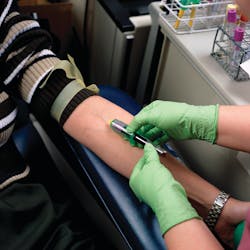Implementing a phlebotomy training program for rural hospital systems
It is well known within the medical field that phlebotomy is one of the most common invasive healthcare procedures performed. Laboratory results from blood collection play a significant role in assisting medical providers as they make critical decisions about patient care, including formulating proper diagnoses and treatments for patients. Although a common procedure performed daily in hospitals, the knowledge, skills and abilities needed to perform phlebotomy successfully may be underestimated by some healthcare leaders. Despite standards and guidelines set in place by organizations such as OSHA (Occupational Safety and Health Administration), CLIA (Clinical Laboratory Improvement Amendments), CAP (College of American Pathologists) and CLSI (Clinical and Laboratory Standards Institute), qualifications to apply for a position as a phlebotomist vary greatly among states.
As an example, to perform phlebotomy in the state of California, most healthcare organizations (HCOs) require applicants to: 1) be a high school graduate or have passed the GED test; 2) complete a phlebotomy program accredited by the California Department of Public Health; 3) pass a national certification examination from a certifying organization approved by the California Department of Public Health; and 4) apply and obtain a California Certified Phlebotomy Technician I certificate. Alternatively, to perform phlebotomy in the state of South Dakota, most HCOs require applicants to: 1) be a high school graduate or have passed the GED test, and 2) prior healthcare experience is preferred but not typically required.
Since applicant standards vary across the country, it may be extremely beneficial for a hospital system located in, or whose service area is in, a rural or medically underserved area to establish an in-house phlebotomy training program. This work presents a framework for implementation of a formalized phlebotomy training program for such hospital systems.
Proposed framework
The following framework will feature steps that are critical in establishing a phlebotomy clinical support service training program within a rural-based hospital system.
Part I: Identifying hospital system challenges
A collaborative effort with a hospital Health Services Administrator (HSA) to determine underlying challenges to implementing a training program is a priority. An HSA should have intimate knowledge of how each of the healthcare provider positions support healthcare delivery; including the formulation of goals, decision-making, planning, organizing, monitoring and controlling overall health system operations. Additionally, an HSA will be helpful in analyzing and integrating decision-making toward designing the organizational structures to meet regulatory standards and achieve optimal organizational performance specific to strategic planning, operations management and employee development.
Part II: Proposing objectives
The following are proposed objectives of implementing a formal phlebotomy training program for a rural hospital system. It’s important to note that these objectives may be addressed in an order that best suits the HCO.
- Objective 1: Standardize phlebotomy training throughout the organization in order to consistently provide excellent patient care.
- Objective 2: Establish a local testing site in order to increase accessibility for laboratory caregivers wishing to complete a national certification examination.
- Objective 3: Identify process improvement opportunities related to phlebotomy processes and identify performance measurements.
- Objective 4: Reduce pre-analytical caregiver turnover rate.
The following are strategies for achieving the stated objectives:
Develop a formal phlebotomy training program that is approved by the National Accrediting Agency for Clinical Laboratory Sciences (NAACLS) to ensure industry and academic standards are met.
Partner with a national certification organization in order to offer testing for Phlebotomy Technician Certification (CPT) through the hospital system or a nearby testing site.
Ensure the hospital system has the resources and support needed for implementing and sustaining a training program such as education coordinators, certified trainers, continuing education opportunities including recertification, technical support, training rooms, training equipment, etc.
Develop quality measures for success such as tracking the number of successful draws phlebotomists have after completing formal training, tracking the number of on-the-job-related injuries due to needle stick injuries, collecting client/patient feedback pertaining to phlebotomy experience, collecting caregiver information regarding the level of confidence and preparedness they feel they have due to the training, etc.
Part III: Measuring and monitoring success factors
In order to ensure the success of a phlebotomy program, the hospital system should collect data prior to its implementation. Factors such as phlebotomists’ first attempt success rate, quantity not sufficient (QNS) rate, phlebotomists’ success ratio (number of successful draws versus number of draws attempted), number of years of phlebotomy experience (if any), program completion rate and pass rate of a national certification examination on the first attempt should also be considered.
In-house training program example
In response to increasing turnover rates and lack of qualified, properly trained phlebotomists, the Medical Center of Central Georgia in Macon developed an in-house training program that provides the necessary instruction to become a skilled phlebotomist.1 A unique model was developed to satisfy the needs of the HCO by hiring phlebotomy students as full-time temporary employees, while completing a 16-week didactic-clinical externship onsite.1 Phlebotomy trainees received a total of 115 hours of classroom instruction and completed 475 hours of clinical experience; covering material that allows trainees to sit for a national certification exam.1
Of the 73 phlebotomy students hired through this training program, approximately 80 percent completed the program and 90 percent passed the certification exam.1 The phlebotomy training program had a significant impact on phlebotomist turnover rate, dropping from 57 percent to 20 percent.1 The institution of this program also gave rise to a full-time phlebotomy instructor/directory position, with responsibilities such as providing specific continuing education for the phlebotomy department, individual retraining opportunities and in-service opportunities for nursing personnel.1 The attention to phlebotomy education assisted the Medical Center with improving specimen quality and safe collection practices throughout the HCO.1
In conclusion
Formal education and training serve as intangible resources for hospitals because they provide economic value to individual workers. Human capital, also inclusive of individual experience, has been shown to not only increase productivity but also an organization’s (i.e. hospital system) profitability. The ability of an organization to foster and increase the development of a work force’s human capital is therefore a concerted effort that is expected to result in tangible outcomes. It stands to reason that training should be viewed as a human capital investment that can increase patient care, efficiency and ultimately, financial performance. Moreover, research indicates that formal onboarding and training is much more effective in helping new hires adjust to the organization, learn their role and increase retention rates. The Society for Human Resource Management (SHRM) defines formal onboarding as a written set of coordinated policies and procedures that assist an employee in adjusting to his or her new job in terms of both tasks and socialization.2 Thus, it stands to reason that establishing a formal phlebotomy program may help maximize success and the overall attainment of the hospital system’s laboratory personnel, particularly in rural areas.
REFERENCES
- Presley CH, Liotta M. How and why to start in-house phlebotomy training. MLO: Medical Laboratory Observer. 2006;38(8):48-49.
- Bauer TN. SHRM foundation’s effective practice guidelines series onboarding new employees: maximizing success. 2010;2.
About the Author

Atheena Therese Estrada, MBA, CPT(NHA)
serves as a Talent Development Consultant within the healthcare industry. She has gained experience as an EMT, phlebotomist, laboratory assistant and a laboratory educator, working in various departments including the clinical laboratory, ED, ICU and NICU.

Jewel Goodman Shepherd, MPA, CHES, PhD
serves as Assistant Professor of Health Services Administration and Faculty Coordinator (Program Director) for the MBA Program with Beacom School of Business, University of South Dakota. She has industry experience in community health and more than 15 years of collegiate level teaching.

Marcie Sariol, MBA, PhD
serves as Assistant Professor of Management, Valparaiso University, Indiana. She teaches cross-cultural management and business policy and strategy to both undergraduate and graduate students.
